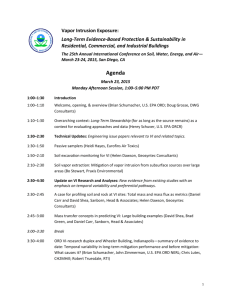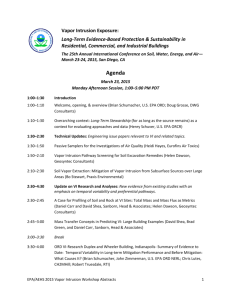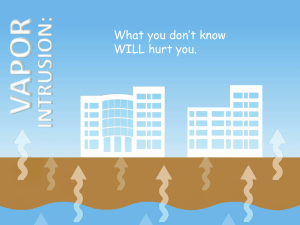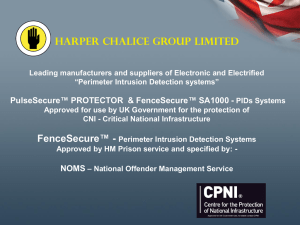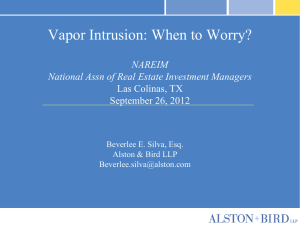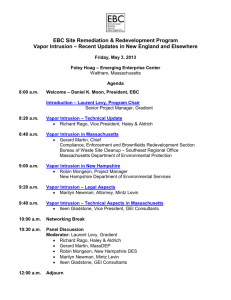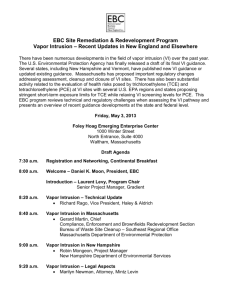The surfacing of toxic vapor into our communities is one of the
advertisement
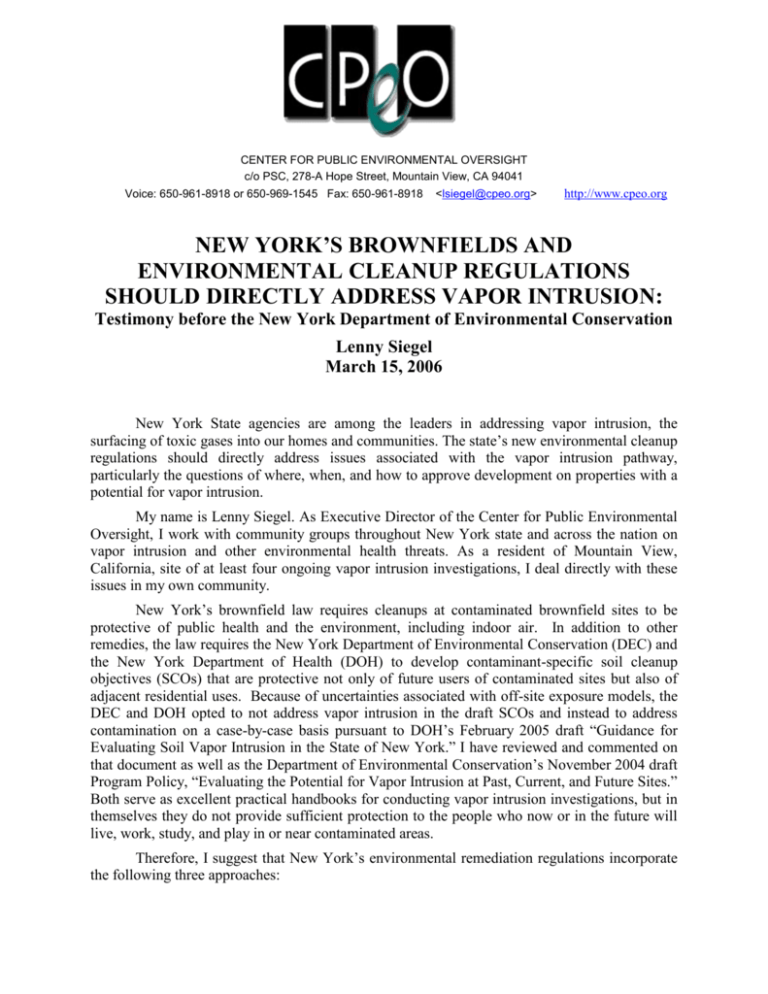
CENTER FOR PUBLIC ENVIRONMENTAL OVERSIGHT c/o PSC, 278-A Hope Street, Mountain View, CA 94041 Voice: 650-961-8918 or 650-969-1545 Fax: 650-961-8918 <lsiegel@cpeo.org> http://www.cpeo.org NEW YORK’S BROWNFIELDS AND ENVIRONMENTAL CLEANUP REGULATIONS SHOULD DIRECTLY ADDRESS VAPOR INTRUSION: Testimony before the New York Department of Environmental Conservation Lenny Siegel March 15, 2006 New York State agencies are among the leaders in addressing vapor intrusion, the surfacing of toxic gases into our homes and communities. The state’s new environmental cleanup regulations should directly address issues associated with the vapor intrusion pathway, particularly the questions of where, when, and how to approve development on properties with a potential for vapor intrusion. My name is Lenny Siegel. As Executive Director of the Center for Public Environmental Oversight, I work with community groups throughout New York state and across the nation on vapor intrusion and other environmental health threats. As a resident of Mountain View, California, site of at least four ongoing vapor intrusion investigations, I deal directly with these issues in my own community. New York’s brownfield law requires cleanups at contaminated brownfield sites to be protective of public health and the environment, including indoor air. In addition to other remedies, the law requires the New York Department of Environmental Conservation (DEC) and the New York Department of Health (DOH) to develop contaminant-specific soil cleanup objectives (SCOs) that are protective not only of future users of contaminated sites but also of adjacent residential uses. Because of uncertainties associated with off-site exposure models, the DEC and DOH opted to not address vapor intrusion in the draft SCOs and instead to address contamination on a case-by-case basis pursuant to DOH’s February 2005 draft “Guidance for Evaluating Soil Vapor Intrusion in the State of New York.” I have reviewed and commented on that document as well as the Department of Environmental Conservation’s November 2004 draft Program Policy, “Evaluating the Potential for Vapor Intrusion at Past, Current, and Future Sites.” Both serve as excellent practical handbooks for conducting vapor intrusion investigations, but in themselves they do not provide sufficient protection to the people who now or in the future will live, work, study, and play in or near contaminated areas. Therefore, I suggest that New York’s environmental remediation regulations incorporate the following three approaches: Siegel: Vapor Intrusion Testimony 2 March 15, 2006 • The known or likely presence of any volatile organic compound below or near a property should trigger a tiered vapor intrusion screening, based upon vapor-phase sampling, and the SCO’s required by statute should err on the side of caution. • New York should impose short-term institutional controls, requiring vapor intrusion investigations, upon any property participating in its cleanup programs that is suspected of current or future vapor intrusion. • New York should convene community advisory groups at vapor intrusion investigation sites where there is sufficient public interest. Vapor-Phase Sampling is Necessary New York regulations should be clear: The known or likely presence of any volatile organic compound—such as trichloroethylene, perchloroethylene, vinyl chloride, trichloroethane, etc.—below or near a property being addressed by any of New York’s cleanup programs should trigger a tiered vapor intrusion screening, based upon soil gas sampling as well as indoor air testing and subslab soil gas sampling where there are existing structures. Top-notch scientists have devoted a great deal of time and effort into predicting vapor intrusion levels from other measurements, but no one has establish a clear quantitative correlation between either soil contamination or groundwater concentrations and indoor air releases. For this reason, California’s Office of Environmental Health Hazard Assessment (OEHHA) “recommends using soil gas analyses for screening purposes whenever site history or soil analysis indicates that any of the volatile chemicals listed … is present.”1 I support this approach, in New York, California, and elsewhere, except that in many cases I agree with New York’s position that mitigation or remediation is a more suitable, cost-effective response than continuing investigation. In addition, the Soil Cleanup Objectives for volatile organic compounds, required by New York law, should take vapor intrusion into account, with the intent of minimizing the amount of these contaminants left behind on a “cleaned” site. Though I lack the technical expertise to propose numbers of my own, I am persuaded by the research of Cornell University’s Anthony Hay, who, I believe, has submitted his own comments on these regulations. Action Should Precede Development Like other states, New York’s vapor intrusion program has focused on sites with existing structures and ongoing human exposures, and rightfully so. But the widespread presence of volatile organic contamination on properties proposed for reuse requires that policies be put into place as soon as possible to protect future property users, particularly residents and students. It doesn’t make any sense for new construction to occur on such sites before vapor intrusion is studied, and if appropriate, mitigated or remediated.2 New York should automatically impose short-term institutional controls, requiring vapor intrusion investigations, upon any property participating in its cleanup programs that is suspected “Human-Exposure-Based Screening Numbers Developed to Aid Estimation of Cleanup Costs for Contaminated Soil,” Integrated Risk Assessment Section, Office of Environmental Health Hazard Assessment, California Environmental Protection Agency, November, 2004, January 2005 Revision, p. 16. 1 For more on CPEO’s position on redeveloping vapor intrusion sites, see the attached “Brownfields and Vapor Intrusion,” by Lenny Siegel, August 2005. 2 Siegel: Vapor Intrusion Testimony 3 March 15, 2006 of current or future vapor intrusion. Without such enforceable controls, local planning jurisdictions may approve unsafe developments without fully understanding, or even knowing about, vapor intrusion risks. There are three simple reasons for taking such a protective approach: 1. It is much easier and cheaper to conduct appropriate investigations before construction begins. 2. The costs of mitigation and/or remediation are much lower if conducted before development occurs. 3. When people who pay good money to move into new structures, particularly attractive new residences, discover that they are breathing highly toxic substances constantly in their homes, they take the developers, original polluters, and state and local agencies to court. There are some in the development community who are concerned that a protective approach to vapor intrusion will kill otherwise viable transactions, but that is not my intent. I am not against development. In many areas, such as my own community, I support the construction of residences, schools, and other sensitive uses on polluted, former industrial property, but only after the proper, protective steps are taken. I suggest that the best way to encourage suitable development is for agencies to work with developers to streamline investigations and standardize required responses. That is, devise ways to encourage the construction of needed homes and schools without putting the residents and students at risk. Involve the Community More than most other environmental investigations, vapor intrusion studies require the cooperation of the public—particularly when sampling must be done in, below, or adjacent to private residences. This is true during both initial investigations as well as the monitoring that should be routine even after responses are in place. Sampling requires human intrusion into people’s home, inspection of their cupboards and garages, and short-term restrictions on ventilation of their homes. Yet vapor intrusion studies are complicated, usually involving multiple samples, the comparison of indoor air results with ambient outdoor readings, and in many cases complex mathematical modeling. Impacted residents and others have a difficult time understanding, let alone trusting, investigators based upon one or two home visits or public meetings. For these reasons, I recommend that New York convene community advisory groups at vapor intrusion investigation sites where there is sufficient public interest. Such groups build trust among the parties—affected residents, responsible parties, regulators, and other officials— and over a period of time they raise the level of understanding, even of highly technical issues, among regular community participants. Those participants, in turn, are able to explain technical issues to their neighbors as well as to bring neighborhood concerns to the attention of other parties. It is my understanding the New York’s statutes allow for, but do not require, the formation of such groups. Protect the Public The brownfield regulations under discussion here are designed primarily to encourage redevelopment as a mechanism to enable the cleanup of blighted property. In the last few years, however, vapor intrusion has emerged as a potential obstacle to the very reuses that could trigger Siegel: Vapor Intrusion Testimony 4 March 15, 2006 remediation. I believe that it is possible, by expeditiously identifying and addressing sites where there are genuine vapor intrusion concerns, to promote redevelopment while providing the public with the level of protection that it expects. To make this happen, the DEC should include these recommended approaches in the environmental remediation program and use the most conservative assumptions possible when developing SCOs for vapor intrusion chemicals. In addition—and I recognize that this is beyond the scope of these hearings—it is essential that New York state adopt indoor air guidelines which, in the words of the Assembly Committee on Environmental Conservation, ”reflect the most protective assumptions about toxicity and exposure supported by science.”3 People deserve to breathe clean air in their homes. Vapor Intrusion of Toxic Chemicals: An Emerging Public Health Concern, New York State Assembly Committee on Environmental Conservation, January 2006, p. 47. 3

